I love art and illustration. My childhood obsession with the Pre-Raphaelite Brotherhood led to hours with art history texts. I’d need a fortnight just to properly do the Met. And so I love it when SFF books engage with art and culture, providing insight into the history of the world, their aesthetic, and their values. There are plenty of literary works revolving around art, and artists, but SFF provides a number of stories where art matters—to the story, to its society, and to its character.
The Golden Key by Melanie Rawn, Jennifer Roberson, and Kate Elliott
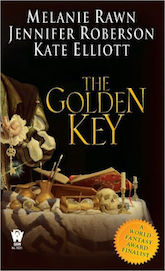 This deeply written novel starts with a series of descriptions of paintings. It’s art nerd heaven—the descriptions are delightfully layered with art criticism, the story of the war, and most of all, the centuries of enmity between the Serranos and the Grijalvas, the foremost painting families of Tira Virte. History is painted by the winners as art serves as the official record of legal treaties, births, marriages, and deaths, and the limners of Tira Virte employ sorcery to manipulate time, history, and people.
This deeply written novel starts with a series of descriptions of paintings. It’s art nerd heaven—the descriptions are delightfully layered with art criticism, the story of the war, and most of all, the centuries of enmity between the Serranos and the Grijalvas, the foremost painting families of Tira Virte. History is painted by the winners as art serves as the official record of legal treaties, births, marriages, and deaths, and the limners of Tira Virte employ sorcery to manipulate time, history, and people.
Passing Strange by Ellen Klages
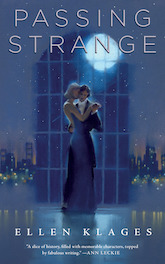 A novella written with the delicacy of the pastel chalks favored by Haskel herself, Passing Strange tells a magical story about a pulp magazine illustrator and a nightclub singer who meet at Mona’s, a queer nightclub where tourists trample through to gawk at the regulars, who glitter and shine anyway. Haskel and Emily’s connection is at once gentle and electric, and the collision of art and magic makes this story one that lingers in the memory.
A novella written with the delicacy of the pastel chalks favored by Haskel herself, Passing Strange tells a magical story about a pulp magazine illustrator and a nightclub singer who meet at Mona’s, a queer nightclub where tourists trample through to gawk at the regulars, who glitter and shine anyway. Haskel and Emily’s connection is at once gentle and electric, and the collision of art and magic makes this story one that lingers in the memory.
Mortal Love by Elizabeth Hand
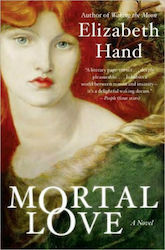 Hand’s sublime book leaps from one century to another, from one artist to another, exploring the popular and often destructive ideas around art, madness, drugs, and visionary creativity. Through every thread of narrative is a woman—chestnut haired, green-eyed, irresistible and dangerous. She’s drawn to artists and leaves devastation behind her as she tries to find her way. When I read it, the part of me that staunchly believes that magic is real, fey, and dangerous wakes up and glides a finger down the nape of my neck.
Hand’s sublime book leaps from one century to another, from one artist to another, exploring the popular and often destructive ideas around art, madness, drugs, and visionary creativity. Through every thread of narrative is a woman—chestnut haired, green-eyed, irresistible and dangerous. She’s drawn to artists and leaves devastation behind her as she tries to find her way. When I read it, the part of me that staunchly believes that magic is real, fey, and dangerous wakes up and glides a finger down the nape of my neck.
Carnival by Elizabeth Bear
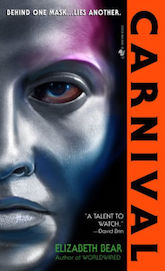 Bear’s super spy SF novel begins with two operatives reuniting after many years to deliver a shipment of stolen artwork to a matriarchal colony planet after years of diplomatic tension—but really they are there to get intelligence for old earth’s government. Don’t walk into this book expecting good vs. evil or any simple, reductive morality—everyone possesses virtues beside their flaws. Come for the art reclamation, stay for the culture building, which won’t be anything like you expect.
Bear’s super spy SF novel begins with two operatives reuniting after many years to deliver a shipment of stolen artwork to a matriarchal colony planet after years of diplomatic tension—but really they are there to get intelligence for old earth’s government. Don’t walk into this book expecting good vs. evil or any simple, reductive morality—everyone possesses virtues beside their flaws. Come for the art reclamation, stay for the culture building, which won’t be anything like you expect.
Borderline by Mishell Baker
 When I heard a friend describe Borderline as “Faerie Muses in Hollywood,” I was one-clicking Baker’s book a minute later and reading all about Millie, a woman who lost her legs in a suicide attempt that ended her run at becoming a filmmaker. After years of therapy and institutionalization, she’s invited to work for The Arcadia Project, a mysterious group who do their best to maintain the treaty between the filmmakers of the mortal world and Faerie. While telling a story with enough investigation to keep me turning pages, Baker has sharp things to say about mental health—and she doesn’t romanticize the image of the tortured artist one bit.
When I heard a friend describe Borderline as “Faerie Muses in Hollywood,” I was one-clicking Baker’s book a minute later and reading all about Millie, a woman who lost her legs in a suicide attempt that ended her run at becoming a filmmaker. After years of therapy and institutionalization, she’s invited to work for The Arcadia Project, a mysterious group who do their best to maintain the treaty between the filmmakers of the mortal world and Faerie. While telling a story with enough investigation to keep me turning pages, Baker has sharp things to say about mental health—and she doesn’t romanticize the image of the tortured artist one bit.
 C.L. Polk writes fiction and spots butterflies in Southern Alberta. She has an unreasonable fondness for knitting, single estate coffee, and the history of fashion. Her debut series beginning with the novel Witchmark is available from Tor.com.
C.L. Polk writes fiction and spots butterflies in Southern Alberta. She has an unreasonable fondness for knitting, single estate coffee, and the history of fashion. Her debut series beginning with the novel Witchmark is available from Tor.com.










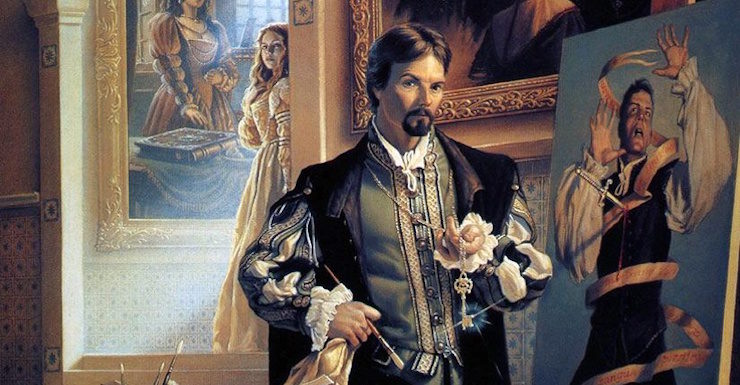
I’ve read and enjoyed four of the five of these. The last…well, she intimidates me.
If we can add one more, Steven Brust’s The Sun, the Moon, and the Stars is wonderful.
I have to recommend Modesitt’s Imager — the protagonist is an artist and the nuances of the local art guilds and materials play an important role in the plot:
“Although Rhennthyl is the son of a leading wool merchant in L’Excelsis, the capital of Solidar, the most powerful nation on Terahnar, he has spent years becoming a journeyman artist and is skilled and diligent enough to be considered for the status of master artisan—in another two years. Then, in a single moment, his entire life is transformed when his master patron is killed in a flash fire, and Rhenn discovers he is an imager—one of the few in the entire world of Terahnar who can visualize things and make them real.”
A recommendation for “The Portrait of Mrs. Charbuque” by Jeffrey Ford.
You left out Memory & Dream by Charles de Lint. One of my favorites! “Isabelle Copley’s visionary art frees ancient spirits. As the young student of the cruel, brilliant artist Vincent Rushkin, she discovered she could paint images so vividly real they brought her wildest fantasies to life. “
I would add Mike Resnick’s The Dark Lady. An alien working in an art gallery, an art thief and an art lover go looking for paintings of a woman who has been the subject of great artists for millennia. And maybe for the woman herself.
Elizabeth Lynn’s A Different Light.
J. G. Ballard’s Vermillion Sands.
If I may plug my own work, let’s include mine and Meriah Crawford’s THE PERSISTENCE OF DREAMS…
It’s set in the Eric Flint’s Ring of Fire alternate history universe, published by Ring of Fire Press, but it’s all about art and art history. It also includes a large appendix describing many famous artists and most of the major art movements throughout history.
Alexander Jablokov’s Carve the Sky concerns itself with art – mainly sculpture.
Always Coming Home, Ursula K. Le Guin: art matters to the Kesh.
Thud!, Terry Pratchett, where the narrative is focussed on a painting of Koom Valley.
The Land of Painted Caves, Jean M. Auel, where the narrative takes a dive into the cave paintings of France when they were fresh and new.
The Fires of Bride, Ellen Galford, about a lesbian painter/sculptor on the imagined-but-somehow-quite-real island on the outermost edge of the Hebrides.
Picture of Dorian Grey?
The Sarantine Mosaic (Sailing to Sarantium and Lord of Emperors) bu Guy Gavriel Kay.
I’d add When the King Comes Home, by Caroline Stevermer. Hail Rosmer’s artistic ambitions and her apprenticeship play a large role in her accidental involvement in politics way out of her league.
For the second time this month, I sing the praises of John Barnes’ Thousand Cultures series, and specifically the first two, A Million Open Doors and Earth Made Of Glass, which are driven almost entirely by art and esthetics.
The Two Georges by Harry Turtledove and Richard Dreyfus also comes to mind. It’s set in an alternate universe where the American Revolution was forestalled by concessions from Britain, and George Washington met with King George, a scene later immortalized in a famous painting, The Two Georges.
“To Say Nothing of the Dog”, by Connie Willis, which is focused around and completely not about locating the whereabouts of something named “The Bishop’s Bird Stump”.
@11 – also The Rock that Changed Things by LeGuin, a small story with large impact.
The Alex Benedict novels by Jack McDevitt…
Glad to see “The Golden Key” making the list, and I second the Sarantine Mosaic.
The Broken Kingdoms, by N.K. Jemisin. The middle book in her “Inheritance” trilogy; art, magic, and magic art.
Lightweavers in the Stormlight archive use art and illusion magic as inspiring “lies”.
The Thrawn Trilogy by Timothy Zahn
Seconding Brust’s The Sun, The Moon, and the Stars.
Adding Creatures of Will and Temper by Molly Tanzer!
It’s the Picture of Dorian Grey but with lesbians and demons. I wouldn’t describe it as “about Art” but art features prominently throughout the novel.
And don’t forget the many works by Lloyd Biggle Jr – especially his Cultural Survey & Jan Darzek books. I especially love “The Still, Small Voice of Trumpets” (what a great title!) and “All the Colors of Darkness” which have aged amazingly well.
There’s a YA book by Michael Dante Dimartino of Avatar: The Last Airbender called Rebel Genius if you want some lighter fare.
C.J.Cherryh: Wave without a Shore – art as world-making
The Lovecraftian world is full of uncanny paintings, including two right here on tor.com: “The Madonna of the Abattoir” and “Crispin’s Model”, both focused on the intimacy between artist and model. I particularly like the second one for using the model’s point of view.
And surely Tolkien’s “Leaf by Niggle” deserves a mention!
There’s only one story I’ve ever read where photography has a major role: Resurrection Man by Sean Stewart. One character takes photographs of the rest of his family and describes them in passionate detail, which turns out to be foreshadowing when the secrets are revealed. I’ve always wondered how Stewart came up with such an original method.
Christopher Moore’s Sacre Bleu should also be on this list.
I also recommend The Sun, the Moon, and the Stars, The Sarantine Mosaic, The Still, Small Voice of Trumpets & All the Colors of Darkness,
Barbara Hambly’s Bride of the Rat God is about the art of film-making in 1920s Hollywood. Not just the stars; the writers, stunt men, photographers, directors. The weapon that Saves the Day is a camera.
William Rotsler’s Patron of the Arts is itself an artistic tragedy. It started as a novelette, published in Terry Carr’s Universe 2. The art in question was the sensatron, a combination of sculpture and broadcast harmonics that shaped the viewer’s emotional response to a given piece. The Patron gets the girl; gets the artist to use her as a subject; gets a transcendent artwork; loses the girl.
The story was a jewel. A perfectly done human tragedy wrapped around an entirely new art form. Here’s the ending:
When I look at my sensatron cube, and all the other Cilentos I have acquired, I am proud to have helped cause the creation of such art. But when I look at the Madelon that is my favorite cube I sometimes wonder if the trade was worth it.
The cube is more than Madelon or the sum of the sum of all the Madelons who ever existed. But the reality of art is not the reality of reality.
Then Rotsler used that story as a starting point for a novel. There’s nothing wrong with that. But in that transition he rewrote the original piece. Bloated it with unnecessary verbiage. You’d think he was getting paid by the word. He started with perfection and he ruined it.
The novel version was acceptable space opera. I could never like it. It wasn’t worth wrecking the original. Read the novel if you like.
But do yourself a favor and find the original novelette.
A few people already mentioned the Sarantine Mosiac which is one of my favorite Kay works.
If we’re counting music, Name of the Wind/Wise Mans’ Fear focus heavily on singing/music, and Shinn’s Archangel trilogy involves singing and music as well as an important feature (thematically as well as being an important plot point). And of course the Silmarillion ;)
Oops! My entry was straight SF, not fantasy. Pulled it.